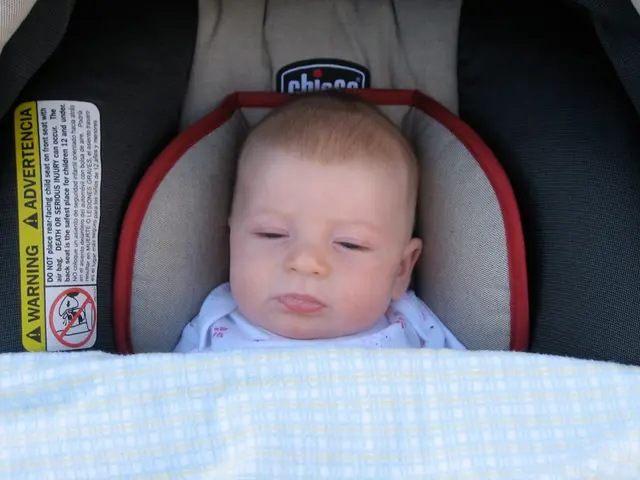Strategies for Supporting Children Suffering from Restless Legs Syndrome
Late Night Woes: Battling Restless Legs Syndrome in Kids
It's bedtime, but your little one just won't snooze. You've tucked them in, turned off the lights, and closed the door. Just when you think they're drifting off, a tiny voice calls out, and you're back to square one.
Restless Legs Syndrome (RLS) in kids might be the culprit. This common condition often goes unnoticed, says pediatric sleep medicine specialist Dr. Lauren Goldman. If your child is kicking, tossing, and turning at night, it's time to take a closer look.
Spotting Restless Legs in Kids
RLS triggers an uncomfortable and uncontrollable urge to move your legs (and occasionally arms or torso). These sensations typically worsen in the evening as your child tries to get some shut-eye. Kids may describe a creepy crawly, uncomfortable feeling that makes their legs jerk or jump, or they might complain that it hurts.
Because RLS messes with sleep, children might struggle with:
- Behavior issues.
- Focus problems.
- Learning difficulties.
Since there's no specific test for RLS, healthcare providers rely on observing symptoms. Younger kids or those with neurodevelopmental disorders may have difficulty explaining their discomfort. In such cases, Dr. Goldman looks for clues, such as a family history of RLS, observed jerky leg movements at night, or frequent leg movements seen during overnight sleep studies.
RLS and ADHD Connection
There's a strong link between RLS and attention-deficit/hyperactivity disorder (ADHD). Approximately 25% of children with RLS exhibit ADHD symptoms, while up to 44% of children with ADHD experience RLS symptoms. The connection between the two conditions isn't fully understood, but iron deficiency seems to play a role in both.
Keeping a Symptom Journal
If you suspect your child has RLS, keeping a symptom journal can help your healthcare provider make an accurate diagnosis and rule out other conditions. Record the following details:
- Timing: When the symptoms occur, their duration, and their frequency.
- Tempo: What makes the symptoms better or worse.
Helping Your Child Sleep Better
As a first step, providers usually recommend non-medication approaches. Here's how to weave these solutions into your kid's bedtime routine:
Consistent Sleep Schedules
Consistent sleep schedules are key to combating RLS. Make sure your child:
- Sticks to a consistent sleep-wake schedule, even on weekends and during vacations.
- Goes to bed at an age-appropriate time to ensure adequate sleep.
Regular Exercise & Kid-Friendly Yoga
Regular exercise and stretching improve blood flow to leg muscles and increase dopamine, which reduces pain. Encourage your child to move daily through sports, playground fun, or kid-friendly yoga videos at home. But be cautious with physical activity right before bedtime, as it can make falling asleep more challenging.
Avoiding Triggers
Common RLS triggers include antihistamines, caffeine, alcohol, and tobacco. If your child needs an antihistamine, take it in the morning instead of at night to minimize RLS symptoms. And steer clear of caffeine, energy drinks, and chocolate late in the day.
Warm Baths & Massage
A warm bath or shower before bed and a gentle leg massage can help reduce RLS symptoms. They can also help your child's muscles relax and promote more restful sleep.
Iron-Rich Diet
Iron deficiency is a leading cause of RLS. Encourage an iron-rich diet by incorporating foods like:
- Meat, poultry, and seafood.
- Dried and canned beans.
- Dried fruits like raisins, figs, and prunes.
- Iron-fortified bread, pasta, and rice.
- Seeds and nuts.
- Tofu.
- Vegetables, including broccoli, potatoes, and dark leafy greens.
A daily multivitamin containing iron is also beneficial with your healthcare provider's approval.
When to Consult a Healthcare Provider
If your child's RLS symptoms are affecting their sleep and daytime routine, it's time to consult a healthcare provider. They can conduct a thorough evaluation, diagnose RLS if possible, and recommend appropriate treatment options.
- The uncomfortable and uncontrollable urge to move one's legs that worsens in the evening, often known as Restless Legs Syndrome (RLS), might be the reason why your child is having trouble sleeping.
- In some cases, healthcare providers, like pediatric sleep medicine specialist Dr. Lauren Goldman, might look for clues such as family history, nightly leg movements, or frequent leg movements during overnight sleep studies to determine if a child has RLS.
- A strong link exists between RLS and attention-deficit/hyperactivity disorder (ADHD), with approximately 25% of children with RLS exhibiting ADHD symptoms, and up to 44% of children with ADHD experiencing RLS symptoms.
- To help understand and diagnose RLS in children, keeping a symptom journal with details about the timing and tempo of the symptoms is beneficial.
- A target-rich diet full of iron-rich foods like meat, poultry, seafood, dried fruits, and iron-fortified grains can help combat Restless Legs Syndrome in children.







